Settings, real and imagined…
Today it’s difficult to determine whether authors have visited any of the settings used in their novels. While I obviously haven’t been to Luna, Mars, or any planet in the 82 Eridani star system (all settings in my sci-fi stories), I’ve traveled a bit on our home planet and observed a lot in situ. But authors can also personalize other settings they’ve never been to by using Google Maps and Google Earth for generalities and then embellishing with their imaginations. There’s nothing wrong with that, and readers can visit faraway places that way.
That said, I traveled recently with my wife to see a few places in Europe we hadn’t seen before. We’d been planning and saving up for this trip for a while. (Readers of this blog probably didn’t even notice, thanks to WordPress’s ability to set up posts ahead of time!)
I knew Europe fairly well, but my knowledge was somewhat one-sided—I’d never visited the ex-Iron Curtain countries after they shed the oppressive yoke of the USSR. Considering that this year we’re celebrating the thirtieth anniversary of the fall of the Berlin wall, the “velvet revolution,” and other freedom movements taking place in 1989, my desire to visit these countries was doubly motivated.
Okay, there was an exception: In 1982, I took a train through the GDR on my way to a conference in West Berlin (I always saw that D in GDR as a grim joke, by the way, and that trip confirmed the black humor of the situation). Some of that experience is reflected in a flashback contained in my new novel from Penmore Press, Son of Thunder.
On our recent tour, we heard stories from locals about how the Russians worked hard to keep people behind the Iron Curtain—true-life stories about a corrupt and oppressive system’s efforts to control people’s lives. Their plight was real. It seems incongruous that now some people in those countries want to cozy up to Putin and his thugs, but newer generations all too often forget the struggles of past generations.
Czechoslovakia was behind the Iron Curtain. It’s now split into two countries, the Czech Republic and Slovakia, both members of the EU (an amicable split for the most part, according to locals). Our first city on the tour was Prague, the old capital and now capital of the Czech Republic. Neither WWII nor the Russians did much to destroy this old, beautiful city with its winding, cobblestoned streets. In the EU, its economy is holding its own, the city is a mix of tradition with cosmopolitan energy, and the people are happy, warm, and friendly. The city is a gem, but I couldn’t help imagining a spy story where drops are made and nefarious plans hatched in the restaurants and night spots—all taking place in the Communist era, of course. Other authors might visit the old castle and imagine knights from the Middle Ages preparing for battles.
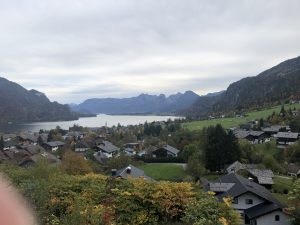
[Left: The Lake District near Linz.]
Linz, Austria was never Communist, but Hitler wanted to make it Austria’s capital and create a new art museum there. The city plays an important role in Rembrandt’s Angel. We used it as a launch pad for a side tour to the Lake District nestled in the foothills of the Alps. Just the landscape alone could become settings for novels in many genres (scenes from The Sound of Music were filmed there).
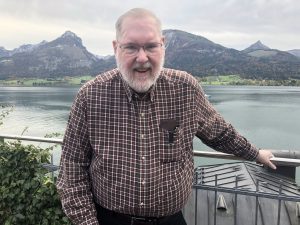
[Right: Steve at the Lake District near Linz.]
Vienna plays an important role in Son of Thunder—it’s where Esther Brookstone appraises a Botticelli painting and finds directions to St. John the Divine’s tomb, and it’s where her old MI6 handler lives. It was never Communist either, but Hitler hated it because a Viennese art school rejected him as a student. (Alternate history theme? What if he hadn’t been rejected?) I’d been to Vienna before, but my wife hadn’t. Schönbrunn Palace is a symbol of the once mighty Austro-Hungarian Empire, but in Son of Thunder, Vienna is also Vindobona, located on the frontier of the once mighty Roman Empire. This illustrates the centuries-long importance of that city on the Danube River (beautiful but not blue).
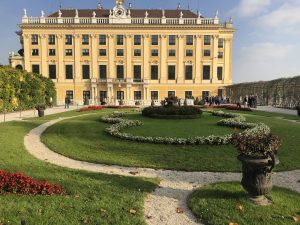
[Left: Schönbrunn Palace, Vienna.]
The river took us to Bratislava, now capital of Slovakia, and Budapest, capital of Hungary. Both cities and countries were behind the Iron Curtain. Czechoslovakia was freed in their “velvet revolution.” Hungary had a more violent uprising against the Soviet hegemony in 1956, but that was crushed, so they too had to wait for 1989. In Pest, the visitor can still observe the pock marks of bullets and shells on many buildings from that 1956 freedom uprising. In Bratislava, most buildings were refurbished and repainted to hide the drab architecture used by the Soviets in their workers’ paradises.
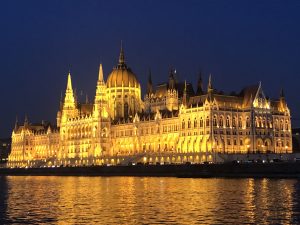
[Right: Parliament Building, Budapest.]
Thanks to the events in 1989, these European countries that were behind the Iron Curtain are now free. Thanks to those events, we can visit these lovely places and marvel at their beauty and meet their lovely people. And, as an author, I could take copious notes and jot down ideas for many future stories!
***
Comments are always welcome.
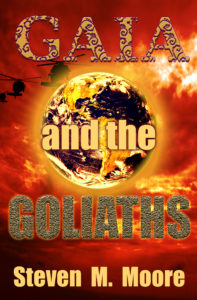
Evergreen Series: “Detectives Chen & Castilblanco.” Seven homicide cases in seven novels that often have national and international implications. The Midas Bomb has the duo fighting terrorism in NYC…and a mysterious hedge fund owner. In Angels Need Not Apply, the enemy is a wily cartel leader. Teeter-Totter between Lust and Murder has the duo battling the illegal gun trade. In Aristocrats and Assassins, a terrorist is kidnapping European royals—for what purpose? The Collector links sex trafficking and stolen artworks when a SoHo gallery owner is murdered. In Family Affiars, Castilblanco struggles to prove a family member didn’t commit murder. And Gaia and the Goliaths embroils the duo in environmental issues when an environmental activist is murdered.
All these books are evergreen—novels as current today as the day I wrote them…maybe even more so. (Note that the principals in the “Esther Brookstone Art Detective Series” have cameos in Aristocrats and Assassins and The Collector.) Available wherever ebooks are sold.
Around the world and to the stars! In libris libertas!
